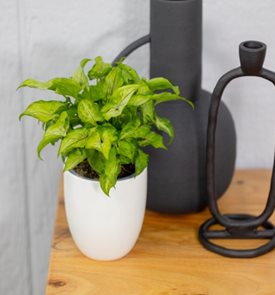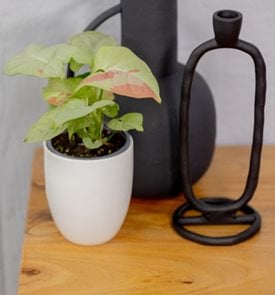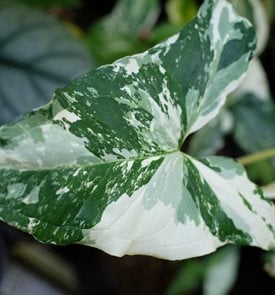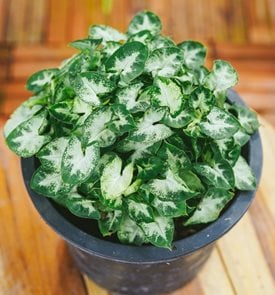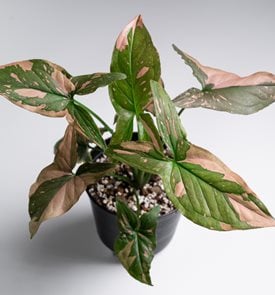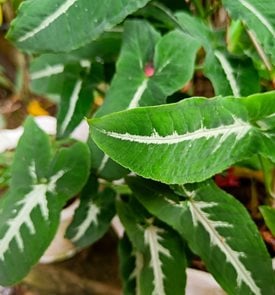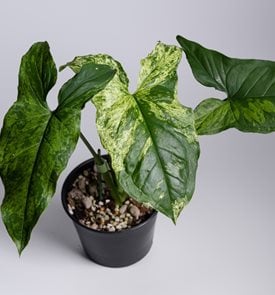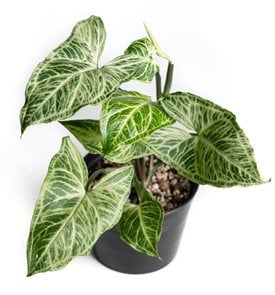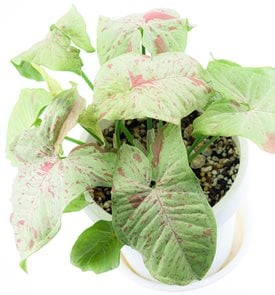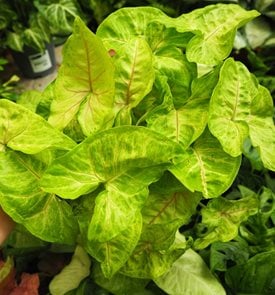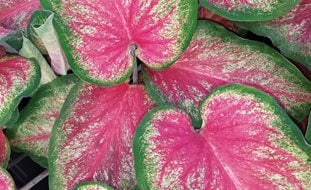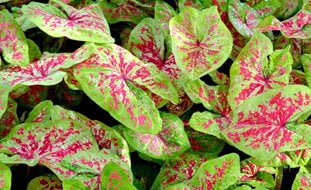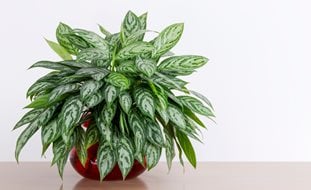How to Grow Arrowhead Vines
Get planting and care tips for growing this showy tropical houseplant. Published 1/11/2024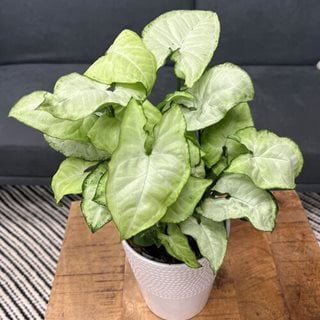
Falling Arrows® White Butterfly arrowhead plant. Photo by: Proven Winners
Aptly named for the distinct shape of its leaves, arrowhead plants are versatile and easy-to-grow, prized for their striking foliage patterns and tolerance for low-light conditions. Young arrowhead plants start out full and bushy, making them perfect for displaying on a desktop, shelf, or table. As the plants mature, they develop a vining habit, allowing you to twine them around a vertical support or drape them over the sides of a hanging basket.
Don’t want your arrowhead plant to climb or trail? No problem. You can prune it to your liking or look for a non-trailing variety that will naturally keep its compact, bushy form.
On this page: Basics | Growing Tips | Care | Varieties | Common Problems | FAQs
On this page:
- ARROWHEAD PLANT BASICS
- GROWING ARROWHEAD PLANTS
- ARROWHEAD PLANT CARE
- ARROWHEAD PLANT VARIETIES
- TROUBLESHOOTING COMMON PROBLEMS
- FREQUENTLY ASKED QUESTIONS
BASICS
Botanical name:
Syngonium podophyllum
Common names:
Arrowhead plant, arrowhead vine, nephthytis, American evergreen, goosefoot plant
Origin:
Native to the tropical regions of Central and South America.
Care level:
Easy
Light requirements:
Low to moderate indirect light
Growth rate:
Moderate to fast
Size:
Can trail or climb up to 6 feet, with the exception of non-trailing types, which rarely grow taller than 12 inches.
Foliage:
May be solid green, variegated, or infused in shades of pink, chartreuse, gold, or dark purple. The leaves change shape as they mature, starting out arrow-shaped and becoming more lobed over time.
Are arrowhead plants toxic?
All parts of Syngonium contain insoluble calcium oxalate crystals, which can be toxic if ingested. The sap can also irritate the skin. Keep out of reach of pets and young children. See more Common Poisonous Plants for Dogs and Cats.
GROWING ARROWHEAD PLANTS
Where to grow:
Although Syngonium can tolerate low-light conditions, it will develop the best foliage color when grown in medium to bright indirect light, such as from of an east- or west-facing window. Avoid exposing to direct sunlight, which can burn the leaves, especially during the summer months.
Temperature and humidity:
Like its close relatives pothos and Philodendron, Syngonium is a tropical plant that loves a warm and humid environment, with temperatures ranging from 65° to 85° F and humidity levels of 40% or higher. Avoid exposing plants to cold drafts or sudden temperature fluctuations.
Tip: During the winter when the indoor air is drier, you can boost the humidity by placing your arrowhead vine in a steamy bathroom, putting it on a gravel tray filled with water, or misting the leaves frequently. See more houseplants that thrive in humidity.
Soil type:
Use a well-draining potting mix with some perlite or orchid bark added to improve drainage and aeration.
Pot requirements:
Plant in a pot about 1 to 2 inches wider than the root ball, with drainage holes to help prevent root rot. If you plan to train the plant up a moss pole, trellis, or other vertical support, use a pot large enough to accommodate the base.
ARROWHEAD PLANT CARE
Watering:
Water to keep the soil evenly moist, but not soggy. Overly wet soil can cause root rot. A good rule of thumb is to give your plant a good soaking when the top inch or two of soil feels dry to the touch, allowing the excess water to drain out the bottom of the pot. In winter, when plant growth slows, it will need less frequent watering.
Fertilizing:
Arrowhead plant doesn’t need much fertilizer to thrive. Feed once per month when actively growing with a liquid houseplant fertilizer diluted to half strength. Withhold fertilizer during the winter months.
Pruning:
If you want to keep your arrowhead plant compact and bushy, prune off any unwanted climbing stems or leggy growth just above a leaf node, wearing gloves to prevent skin irritation. The optimal time for pruning is during spring through late summer, while the plant is actively growing.
Repotting:
Arrowhead vine is a fast grower and will usually need repotting every two years, or whenever you see the roots begin to grow out of the pot’s drainage holes. The best time to repot is in spring, when plants emerge from semi-dormancy. Choose a new container an inch or two larger than the current one, and fill it with fresh potting mix before transplanting.
Propagation:
Arrowhead plants are easily propagated through stem cuttings, placed either in water or soil. Cut a 4- to 6-inch section of the stem just below a leaf node, then put the stem directly in water or plant in moist potting mix. Place your cuttings in a warm spot, in bright indirect light. New roots should appear within a week or two. *See notes below on propagating patented plants (check your plant tags for ® or ™ symbols next to the plant name).
Pests and diseases:
Be on the lookout out for common houseplant pests, such as aphids, mealybugs, spider mites, and thrips. Fungus gnats may also be a problem.
ARROWHEAD PLANT VARIETIES
COMMON PROBLEMS: ARROWHEAD PLANTS
An arrowhead vine is very adaptable and easy to care for, but it may show signs of distress if its basic requirements aren’t being met. Be on the alert for the following symptoms.
- Yellowing leaves: Usually due to overwatering, and often the first sign that root rot may be occurring. Cut back on your watering frequency, and make sure the base of your pot is not sitting in excess water.
- Dry, brown leaf tips: Low humidity and under-watering are the likely causes of leaf tips and edges turning brown. Keeping the soil evenly moist and misting the leaves daily should prevent further browning and shriveling.
- Lack of growth: This can occur when a plant is underfertilized or not getting enough light. It could also indicate that your plant is cramped in its current pot and ready to be transplanted. Don’t be concerned if growth slows down during the winter months.
- Spindly or leggy growth: Often due to a lack of sunlight. If you don't have a spot available with brighter light, try placing your plant under grow lights. Regular pruning can also help prevent leggy growth and maintain a full, bushy appearance.
FREQUENTLY ASKED QUESTIONS
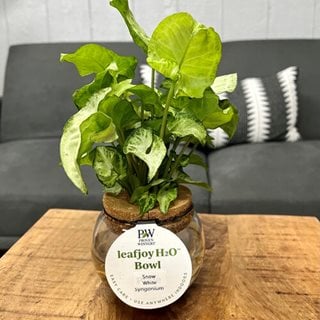
Falling Arrows® Snow White™. Photo by: Proven Winners
Do arrowhead plants flower?
Arrowhead plants rarely bloom indoors and are mainly grown for their colorful foliage. In their native tropical habitat, they may develop green to greenish white flower spikes, or spadices, partially enclosed in leaf-like bract, similar in appearance to the flowers a peace lily.
Can I grow arrowhead plant outdoors?
Arrowhead plants are perennials in zones 10-12, where you can grow them outdoors year-round. In colder climates, grow them as annuals or plant them in containers that you can move indoors in the fall, or as soon as temperatures drop below 50° F. Be sure to check for pests before bringing plants indoors.
Can I grow arrowhead vine in water?
It’s easy to grow arrowhead plant hydroponically by taking stem cuttings from a healthy plant and putting them in a transparent glass jar or a vase filled with non-chlorinated water, making sure that the bottom leaves are not submerged. To keep your cuttings healthy, change the water every few days to prevent bacteria from forming and add a few drops of liquid fertilizer to the water occasionally to provide essential nutrients. Once a stem cutting takes root, you can continue to grow it in water indefinitely.
Or, try growing a leafjoy H2O® Mini, leafjoy H2O® Bowl, or leafjoy H2O® Beaker.
*REGARDING PROPAGATION: When it comes to propagating patented plants, there are strict rules in place prohibiting reproduction or propagation of these plants in any way. This means you can't reproduce them (even for use in your own garden), sell them, or bring them into the country without permission. The law does not make exceptions for what some might consider minor infringements. Any unauthorized use of patented plants is considered an infringement.
